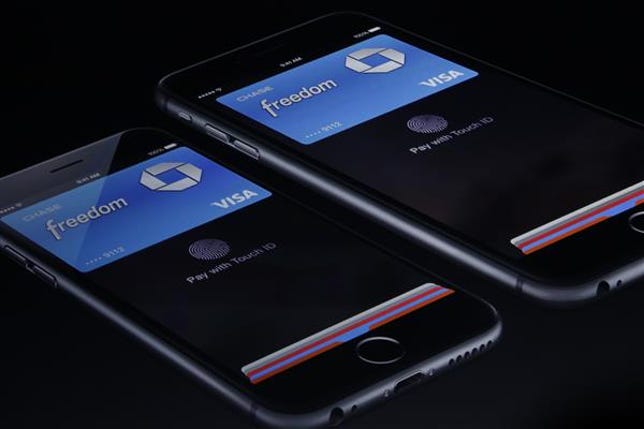
Apple
Apple is slated to roll out Apple Pay on Monday. But just how widely supported is the mobile payment service, and how long could it take to fully ramp up?
Unveiled at last month’s iPhone event, Apple Pay is the company’s first real foray into the world of mobile payments. Using an iPhone 6 or 6 Plus equipped with (NFC) near-field communication, consumers will be able to tap their phones against NFC-enabled point-of-sale systems to pay for items at retail stores and restaurants that have chosen to participate. The idea is to use your iPhone to buy something rather than directly using a credit or debit card. According to Apple, 220,000 retail locations are supporting the service.
But certain obstacles could hamper a rapid, widespread adoption.
Though 220,000 sites seems impressive, some retailers have so far decided not to play ball with Apple Pay. Wal-Mart is one major chain that has has no plans to accept Apple Pay payments, according to BusinessWeek. The retail giant said it’s working with other large retailers on their own payment system developed by a company called Customer Exchange (MCX). Neither Wal-Mart nor MCX would disclose to BusinessWeek why they have rejected Apple Pay. But analysts say the main reason is that the merchants want to maintain control of the customer relationship.
Among the retailers that do support Apple Pay, only a small number so far have NFC-enabled machines that can actually communicate with the iPhone to process the transaction, The Wall Street Journal reported. As one example cited by BusinessWeek, Starbucks still hasn’t put in place the NFC equipment needed to talk to the iPhone.
In addition, the iPhone 6 and iPhone 6 Plus are the only iPhones that possess the necessary NFC hardware. Owners of the iPhone 5S, 5C, and older phones are out of luck. Apple Pay is supported on the new iPad Air 2 and iPad Mini 3 unveiled by Apple last Thursday. But the new iPads also lack NFC technology, which means that people are limited to paying for apps and other items via their devices, with no way to buy physical products at merchants that support Apple Pay.
Apple Pay works by enabling you to type in or scan your credit or debit cards, so the transaction can be processed by your bank. Corporate credit cards and prepaid cards aren’t accepted. Proprietary credit cards, such as those used by Macy’s, are not supported — at least not yet. A spokesman for Macy’s told the Journal that he expects the company’s proprietary card to eventually support Apple Pay.
Related Stories
- Get to know Apple Pay, the successor to your wallet
- Hello, Apple Pay, good-bye credit cards? All bets are off
- Apple’s iOS 8.1 hits Monday with Apple Pay, iCloud photo library
- Apple iPads add Touch ID in catch-up with iPhone
And in light of security concerns, will consumers feel comfortable using their phone to pay for products? Apple has striven to address security fears with a two-step approach.
First, to initiate a transaction, you must use your fingerprint to tap the Touch ID button as a way to ensure that you’re the actual owner. Second, a special chip that’s built into only the iPhone 6 and iPhone 6 Plus stores your financial information. That chip is accessed when a random 16-digit number is generated for your transaction. The data stored on the chip cannot be accessed by anyone hacking into your phone, as the chip itself would shut down if it sensed any tampering.
Still, whether that process will convince security-conscious consumers to trust their iPhones to pay for goods is a question.
Certainly, growing pains are to be expected with any new technology service, especially when different industries and players are involved. Over time, more merchants will likely set up the necessary NFC equipment, and more retailers will likely support Apple Pay, especially if it grows in popularity among consumers. Apple anticipates some of those growing pains but contends the service will be successful in the long run.
“We’re trying to do something that I think is a game changer and it requires a lot of people to play together,” Eddy Cue, Apple’s senior vice president in charge of Internet software and services, told the Journal. “There’s a lot to do here and we have a lot of work to do, but it should be huge.”



